Abstract
In order to overcome the vulnerability of the effect of large passenger flow, an improved method based on the vulnerability of large passenger flow was proposed, and 5-year (2013–2017) passenger flow techniques are applied. The urban rail transit safety vulnerability simulation model mainly has three modules. Module 1: Urban rail transit can respond to disturbances in time and make corresponding adjustments and adaptations. Module 2: Urban rail traffic can be restored to a completely normal state for certain disturbances. Module 3: Urban rail transit can be completed within a limited self-recovery and adjustment time, and the fragile state after disturbance can be restored to normal state in time. This section of urban rail transit safety vulnerability evolution model is the core of the algorithm is studied, and according to the model to design the best algorithm procedures, specific algorithm to run the program is shown in Fig. 1. The results of this paper can be used as a basis for solving safety problems. It can in turn help to avoid or reduce the occurrence of disasters and to ensure the safe, fast and efficient operation of subway. This work has significance in theory and practice.


Similar content being viewed by others
References
Hong et al (2016) New light rail transit and active travel: a longitudinal study. Transp Res Part A 92:131–144
Adger WN (2006) Vulnerability. Glob Environ Change 16:268–281
Chen Anthony, Yang Chao et al (2007) Network-based accessibility measures for vulnerability analysis of degradable transportation networks. Netw Spat Econ 7(3):241–256
Downing TE (2000) Towards a vulnerability science? [J/OL]. IHDP Newsletter Update, 3
Yuan P, Song S et al (2015) Study on the vulnerability evaluation of components of urban rail transit system. China Saf Sci Technol 07:142–149
Erath A, Birdsall J, Axhausen KW, Hajdin R (2009) Vulnerability assessment of the Swiss road network. 88th Transportation research board annual meeting, Washington, pp 1–17
Erath A, Birdsall J et al (2010) Vulnerability assessment methodology for swiss road network. J Transp Res Board 2137:118–126
Fang LB, Cai JD (2011) Reliability assessment of microgrid using sequential Monte Carlo simulation. J Electron Sci Technol 2011:31–34
Li F, Bi Jun et al (2010) Mapping human vulnerability to chemical accidents in the vicinity of chemical industry parks. J Hazard Mater 179:500–506
Gallopín GC (2006) Linkages between vulnerability, resilience, and adaptive capacity. Glob Environ Change 16(3):293–303
Gallopin GC (2006) Linkages between vulnerability, resilience, and adaptive capacity. Glob Environ Change 16:293–303
Kim Hyun (2009) Geographical analysis on network reliability of public transportation systems: a case study of subway network system in Seoul. J Korean Geogr Soc 44(2):187–205
Jenelius E, Mattsson Lars-Gran. Developing a methodology for road network vulnerability analysis. 12th–13th Nectar cluster 1 seminar, Molde University College, Molde
Hinkel Jochen (2011) “Indicators of vulnerability and adaptive capacity”: towards a clarification of the science–policy interface. Glob Environ Change 21(1):198–208
Luers AL, Lobell DB, Sklar LS et al (2003) A method for quantifying vulnerability, applied to the agricultural system of the Yaqui Valley, Mexico. Glob Environ Change 13(4):255–267
Demichela M (2013) Vulnerability assessment for human targets due to ash fallout from Mt. Etna. Chem Eng 32:445–450
Yuan P, Song S et al (2014) Fire prediction based on combinational optimization model of gray neural network. China Saf Sci Technol 03:119–124
Yuan P, Song S et al (2015) Study on the cusp catastrophe of employees’ unsafe behavior. J Saf Environ 03:165–169
Yuan P, Song S et al (2014) Urban vulnerability modeling and simulation under climate change. Urb Dev Res 01:54–60
Criado R, Hernández-Bermejo B et al (2007) Efficiency, vulnerability and cost: an overview with applications to subway networks worldwide. Int J Bifurc Chaos 17(7):2289–2301
Criado Regino, Pello Javier et al (2009) A node-based multiscale vulnerability of complex networks. Int J Bifurc Chaos 19(2):703–710
Mitra SK, Saphores J-DM (2016) The value of transportation accessibility in a least developed country city—the case of Rajshahi City, Bangladesh. Transp Res Part A Policy Pract 89:184–200
Smit B, Wandel J (2006) Adaptation, adaptive capacity and vulnerability. Glob Environ Change 16(3):282–292
Song S et al (2016) Study on the influencing factors of electric fire in metro based on vulnerability theory. J Xi’an Univ Sci Technol 05:691–696
Thirumalaivasan D, Karmegam M, Venugopal K (2003) AHP-DRASTIC: software for specific aquifer vulnerability assessment using DRASTIC model and GIS. Environ Model Softw 18(7):645–656
Acknowledgements
This research was supported by Institute of Risk and Insurance. The authors thank Institute of Risk and Insurance for the support in data access. We would also like to acknowledge the editor. The work was supported by Beijing Social Science Foundation (14JDJGC011).
Author information
Authors and Affiliations
Corresponding author
Ethics declarations
Conflict of interest
The authors declare that they have no conflict of interest.
Rights and permissions
About this article
Cite this article
Wang, L., Chen, Y. & Wang, C. Research on evolutionary model of urban rail transit vulnerability based on computer simulation. Neural Comput & Applic 32, 195–204 (2020). https://doi.org/10.1007/s00521-018-3793-6
Received:
Accepted:
Published:
Issue Date:
DOI: https://doi.org/10.1007/s00521-018-3793-6




